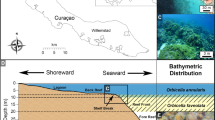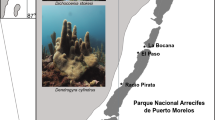Abstract
It has been hypothesized that endolithic photo-autotrophs inside the skeleton of cold-water corals may have a mutualistic relationship with the coral host positively affecting coral calcification. This study investigated the effect of endolithic photo-autotrophs on the apical septal extension of the cold-water coral Desmophyllum dianthus at Fjord Comau, southern Chile (42.41°–42.15°S, 72.5°W). The fluorescent staining agent calcein was used to document the linear apical extension of septae for a period of one and a half years between 2006 and 2007. The results showed a severe reduction in extension rates associated with the presence of endolithic photo-autotrophs. Infested individuals grew about half as fast as non-infested polyps with a median value of 1.18 μm day−1 compared to 2.76 μm day−1. Contrary to the initial hypothesis, these results point toward a parasitic relationship between D. dianthus and its endolithic photo-autotrophs potentially impairing coral fitness. However, further data on physiological parameters and other aspects of the calcification process are necessary to confirm these findings.





Similar content being viewed by others
References
Adkins JF, Henderson GM, Wang S-L, O’Shea S, Mokadem F (2004) Growth rates of the deep-sea scleractinia Desmophyllum cristagalli and Enallopsammiarostrata. Earth Planet Sci Lett 227:481–490
Aeby GS, Williams GJ, Franklin EC, Haapkyla J, Harvell CD, Neale S, Page CA, Raymundo L, Vargas-Ángel B, Willis BL, Work TM, Davy SK (2011) Growth anomalies on the coral genera Acropora and Porites are strongly associated with host density and human population size across the Indo-Pacific. PLoS ONE 6:e16887
Beuck L, Vertino A, Stepina E, Karolczak M, Pfannkuche O (2007) Skeletal response of Lopheliapertusa (Scleractinia) to bioeroding sponge infestation visualised with micro-computed tomography. Facies 53:157–176
Brahmi C, Meibom A, Smith DC, Stolarski J, Auzoux-Bordenave S, Nouet J, Doumenc D, Djediat C, Domart-Coulon I (2009) Skeletal growth, ultrastructure and composition of the azooxanthellate scleractinian coral Balanophylliaregia. Coral Reefs 29:175–189
Cairns SD, Häussermann V, Försterra G (2005) A review of the Scleractinia (Cnidaria: Anthozoa) of Chile, with the description of two new species. Zootaxa 1018:15–46
Dissard D, Nehrke G, Reichart GJ, Nouet J, Bijma J (2009) Effect of the fluorescent indicator calcein on Mg and Sr incorporation into foraminiferal calcite. Geochem Geophys Geosyst 10:1–13
Domart-Coulon IJ, Traylor-Knowles N, Peters E, Elbert D, Downs CA, Price K, Stubbs J, McLaughlin S, Cox E, Aeby G, Brown PR, Ostrander GK (2006) Comprehensive characterization of skeletal tissue growth anomalies of the finger coral Porites compressa. Coral Reefs 25:531–543
Fine M, Loya Y (2002) Endolithic algae: an alternative source of photoassimilates during coral bleaching. Proc R Soc B 269:1205–1210
Försterra G, Häussermann V (2003) First report on large scleractinian (Cnidaria: Anthozoa) accumulations in cold-temperate shallow water of south Chilean fjords. Zool Verh Leiden 345:117–128
Försterra G, Häussermann V (2008) Unusual symbiotic relationships between microendolithic phototrophic organisms and azooxanthellate cold-water corals from Chilean fjords. Mar Ecol Prog Ser 370:121–125
Försterra G, Beuck L, Häussermann V, Freiwald A (2005) Shallow-water Desmophyllum dianthus (Scleractinia) from Chile: characteristics of the biocoenoses, the bioeroding community, heterotrophic interactions and (paleo)-bathymetric implications. In: Freiwald A, Roberts JM (eds) Cold-water corals and ecosystems. Springer, Berlin, pp 937–977
Gattuso JP, Allemand D, Frankignoulle M (1999) Photosynthesis and calcification at cellular, organismal and community levels in coral reefs: a review on interactions and control by carbonate chemistry. Am Zool 39:160–183
Golubic S, Radtke G, Le Campion-Alsumard T (2005) Endolithic fungi in marine ecosystems. Trends Microbiol 13:229–235
Gutner-Hoch E, Fine M (2011) Genotypic diversity and distribution of Ostreobiumqueckettii within scleractinian corals. Coral Reefs 30:643–650
Highsmith RC (1981) Lime-boring algae in hermatypic coral skeletons. J Exp Mar BiolEcol 55:267–281
Iriarte J, González H, Liu K, Rivas C, Valenzuela C (2007) Spatial and temporal variability of chlorophyll and primary productivity in surface waters of southern Chile (41.5-43 S). Estuar Coast Shelf Sci 74:471–480
Kanwisher JW, Wainwright SA (1967) Oxygen balance in some reef corals. Biol Bull 133:378–390
Lazier AMYV, Smith JE, Risk MJ, Schwarcz HP (1999) The skeletal structure of Desmophyllum cristagalli: the use of deep-water corals in sclerochronology. Lethaia 32:119–130
Le Campion-Alsumard T, Golubic S, Priess K (1995a) Fungi in corals: symbiosis or disease? Interaction between polyps and fungi causes pearl-like skeleton biomineralization. Mar Ecol Prog Ser 117:137–147
Le Campion-Alsumard T, Golubic S, Hutchings P (1995b) Microbial endoliths in skeletons of live and dead corals: Porites lobata (Moorea, French Polynesia). Mar Ecol Prog Ser 117:149–157
Maier C, Watremez P, Taviani M, Weinbauer MG, Gattuso J-P (2012) Calcification rates and the effect of ocean acidification on Mediterranean cold-water corals. Proc R Soc Lond B 279:1713–1723
Marschal C, Garrabou J, Harmelin JG, Pichon M (2004) A new method for measuring growth and age in the precious red coral Coralliumrubrum (L.). Coral Reefs 23:423–432
Marshall AT, Clode P (2004) Calcification rate and the effect of temperature in a zooxanthellate and an azooxanthellate scleractinian reef coral. Coral Reefs 23:218–224
McClanahan TR, Weil E, Maina J (2009) Strong relationship between coral bleaching and growth anomalies in massive Porites. Glob Change Biol 15:1804–1816
McCulloch M, Trotter J, Montagna P, Falter J, Dunbar R, Freiwald A, Försterra G, Correa ML, Maier C, Rüggeberg A, Taviani M (2012) Resilience of cold-water scleractinian corals to ocean acidification: boron isotopic systematics of pH and saturation state up-regulation. Geochim Cosmochim Acta 87:21–34
Miller KJ, Rowden AA, Williams A, Häussermann V (2011) Out of their depth? Isolated deep populations of the cosmopolitan coral Desmophyllum dianthus may be highly vulnerable to environmental change. PLoS ONE 6:e19004
Moran AL (2000) Calcein as a marker in experimental studies newly-hatched gastropods. Mar Biol 137:893–898
Naumann MS, Orejas C, Wild C, Ferrier-Pagès C (2011) First evidence for zooplankton feeding sustaining key physiological processes in a scleractinian cold water coral. J Exp Mar Biol Ecol 214:3570–3576
Naumann MS, Orejas C, Ferrier-Pagès C (2013) High thermal tolerance of two Mediterranean cold-water coral species maintained in aquaria. Coral Reefs. doi:10.1007/s00338-013-1011-7
Odum HT, Odum EP (1955) Trophic structure and productivity of a windward coral reef community on Eniwetok Atoll. Ecol Monogr 25:291–320
Peck LS, Brockington S, Brey T (1997) Growth and metabolism in the Antarctic brachiopod Liothyrellauva. Phil Trans R Soc B 352:851–858
Peck LS, Colman JG, Murray AWA (2000) Growth and tissue mass cycles in the infaunal bivalve Yoldiaeightsi at Signy Island, Antarctica. Polar Biol 23:420–428
Pickard GL (1971) Some physical oceanographic features of inlets of Chile. J Fish Res Bd Canada 28:1077–1106
Risk MJ, Pagani SE, Elias RJ (1987) Another internal clock: preliminary estimates of growth rates based on cycles of algal boring activity. Palaios 2:323–331
Risk M, Heikoop J, Snow M, Beukens R (2002) Lifespans and growth patterns of two deep-sea corals: Primnoaresedaeformis and Desmophyllum cristagalli. Hydrobiologia 471:125–131
Roberts JM, Wheeler AJ, Freiwald A, Cairns SD (2009) Cold water corals. Cambridge University Press, Cambridge
Rowley RJ, Mackinnon DI (1995) Use of the fluorescent marker calcein in biomineralisation studies of brachiopods and other marine organisms. Bull Inst Océanogr (Monaco) 14:111–120
Schlichter D, Berglund O, Backe C, Eklöv A, Järnmark C, Persson A (1995) Transfer of photoassimilates from endolithic algae to coral tissue. Naturwissenschaften 82:559–561
Schlichter D, Kampmann H, Conrady S (1997) Trophic potential and photoecology of endolithic algae living within coral skeletons. Mar Ecol 18:299–317
Shashar N, Stambler N (1992) Endolithic algae within corals-life in an extreme environment. J Exp Mar Biol Ecol 163:277–286
Sorauf JE, Jell JS (1977) Structure and incremental growth in the ahermatypic coral Desmophyllum cristagalli from the North Atlantic. Paleontology 20:1–19
Tambutte E, Tambutte S, Segonds N, Zoccola D, Venn A, Erez J, Allemand D (2011) Calceinlabelling and electrophysiology: insights on coral tissue permeability and calcification. Proc R Soc B 279:19–27
Titlyanov EA, Kiyashko SI, Titlyanova TV, Kalita TL, Raven JA (2008) δ13C and δ15 N values in reef corals Poriteslutea and P. cylindrica and in their epilithic and endolithic algae. Mar Biol 155:353–361
Tribollet A (2008) The boring microflora in modern coral reef ecosystems: a review of its roles. In: Wisshak M, Tapanila L (eds) Current developments in bioerosion. Springer, Berlin, pp 67–94
Waller R (2005) Deep-water Scleractinia (Cnidaria: Anthozoa): current knowledge of reproductive processes. In: Freiwald A, Roberts JM (eds) Cold-water corals and ecosystems. Springer, Berlin, pp 691–700
Waller RG, Tyler PA (2005) The reproductive biology of two deep-water, reef-building scleractinians from the NE Atlantic Ocean. Coral Reefs 24:514–522
Weber JN, White EW, Weber PH (1975) Correlation of density banding in reef coral skeletons with environmental parameters: the basis for interpretation of chronological records preserved in the coralla of corals. Paleobiology 1:137–149
Work T, Aeby G, Coles S (2008) Distribution and morphology of growth anomalies in Acropora from the Indo-Pacific. Dis Aquat Organ 78:255–264
Acknowledgments
Many thanks to Claudio Richter, Kerstin Beyer, Marlene Wall, Lars Beierlein, Johannes Freitag, Sebastian Baumgarten and Tristan Chipchase for supporting CH in her research and the staff of the Huinay Scientific field station for helping to complete the field work for this study (Liz Atwood, David Thompson, Russell Smart, Michelle Marcotte, Josh Biro). PhW was supported by a travel grant from the Fonds Léopold III pour l’Exploration et la Conservation de la Nature. This is publication nr. 82 of Huinay Scientific Field Station.
Ethical statement
To conduct the experiments for this study, the permission to collect samples and the CITES (Convention on International Trade in Endangered Species of Wild Fauna and Flora) permission were obtained in compliance with the laws in Chile where the study was conducted.
Author information
Authors and Affiliations
Corresponding author
Additional information
Communicated by M. Kühl.
Rights and permissions
About this article
Cite this article
Hassenrück, C., Jantzen, C., Försterra, G. et al. Rates of apical septal extension of Desmophyllum dianthus: effect of association with endolithic photo-autotrophs. Mar Biol 160, 2919–2927 (2013). https://doi.org/10.1007/s00227-013-2281-x
Received:
Accepted:
Published:
Issue Date:
DOI: https://doi.org/10.1007/s00227-013-2281-x




